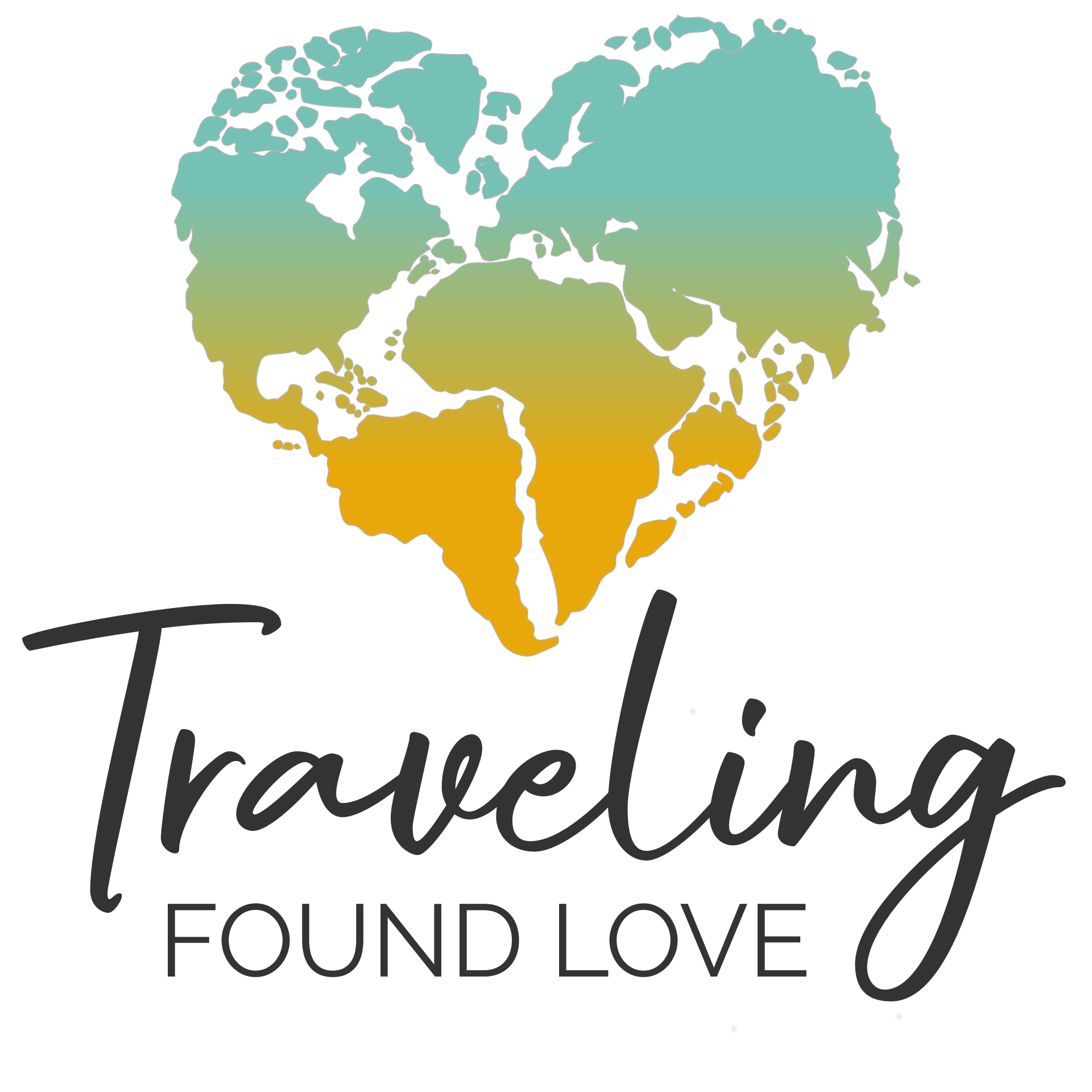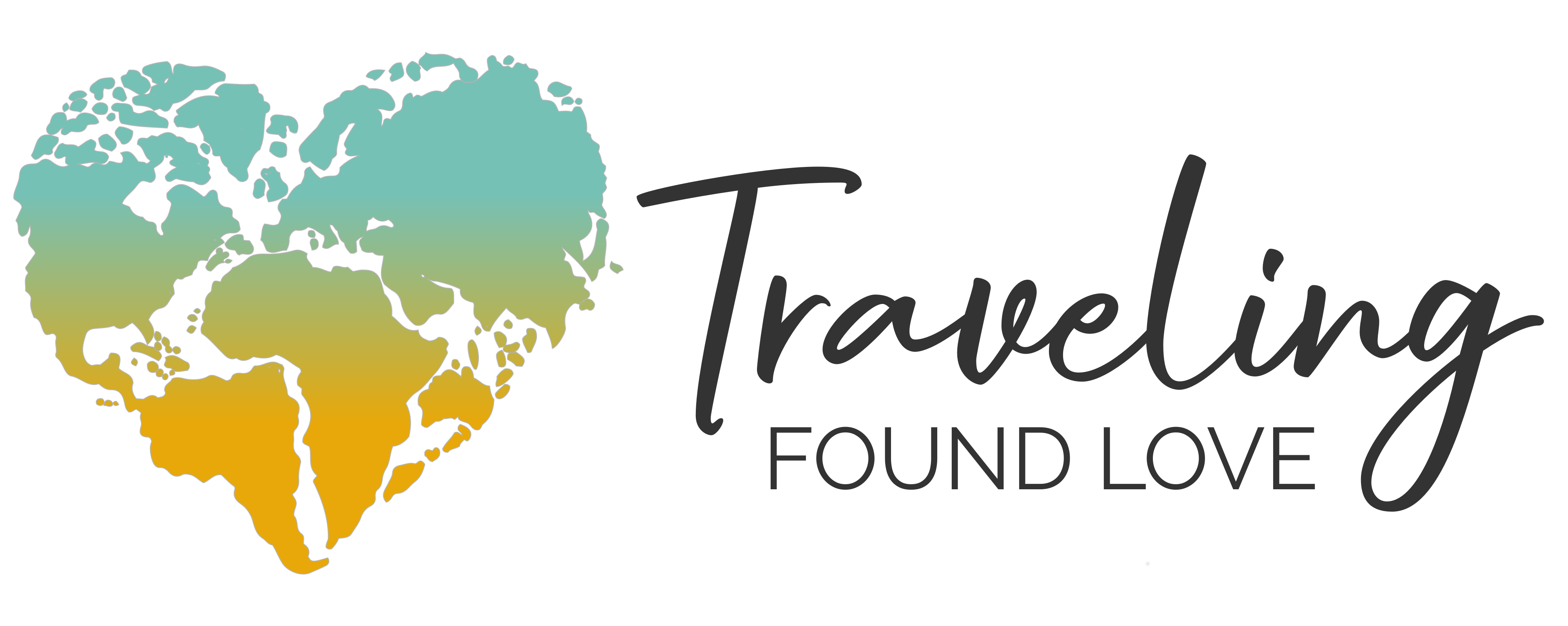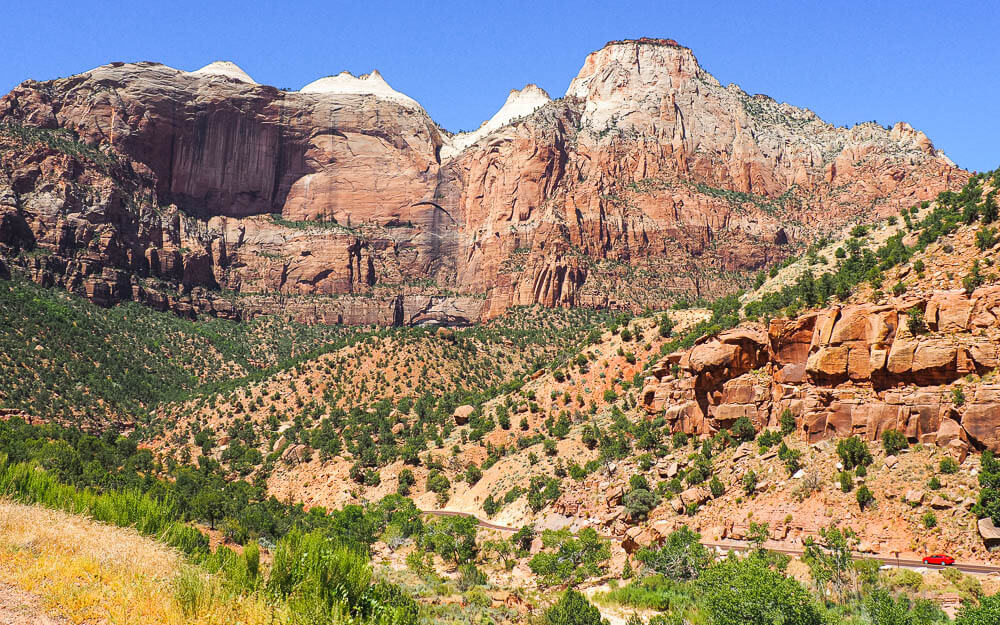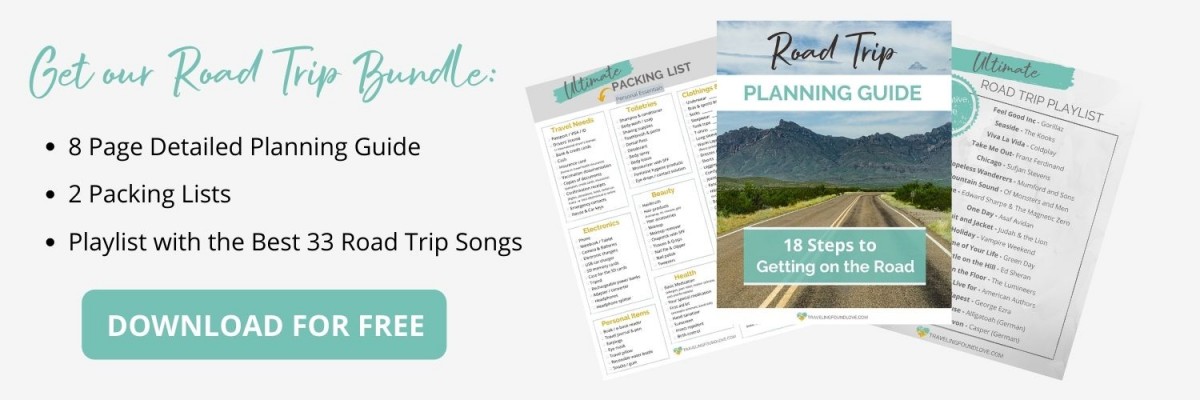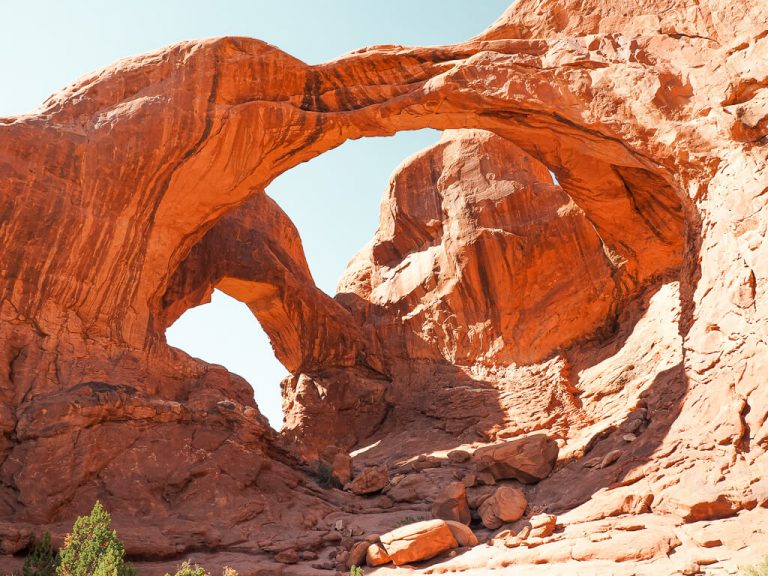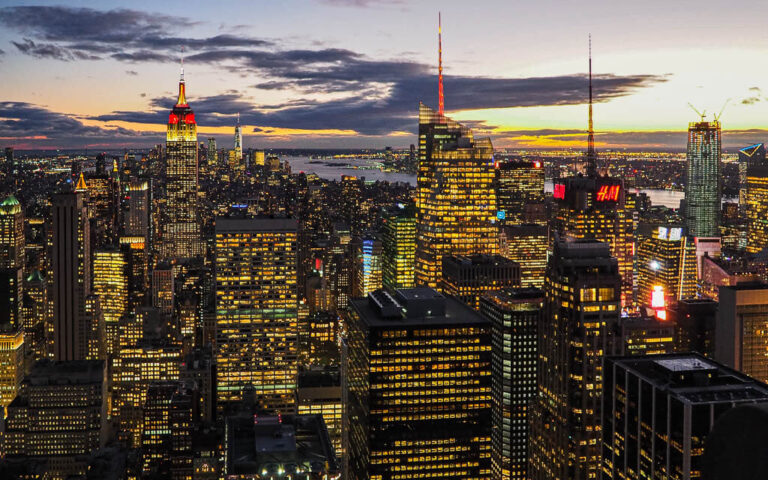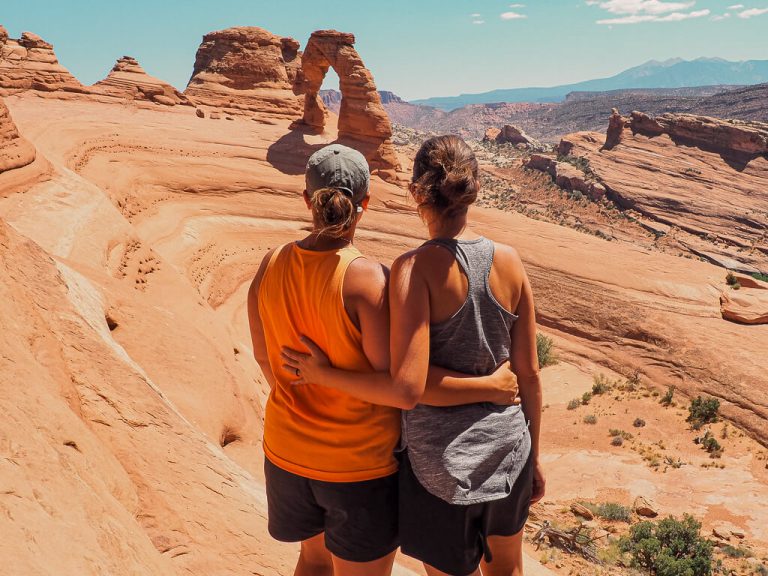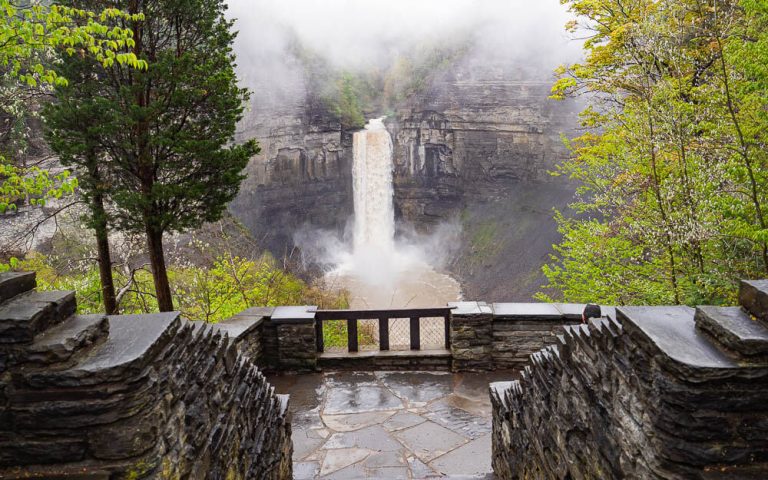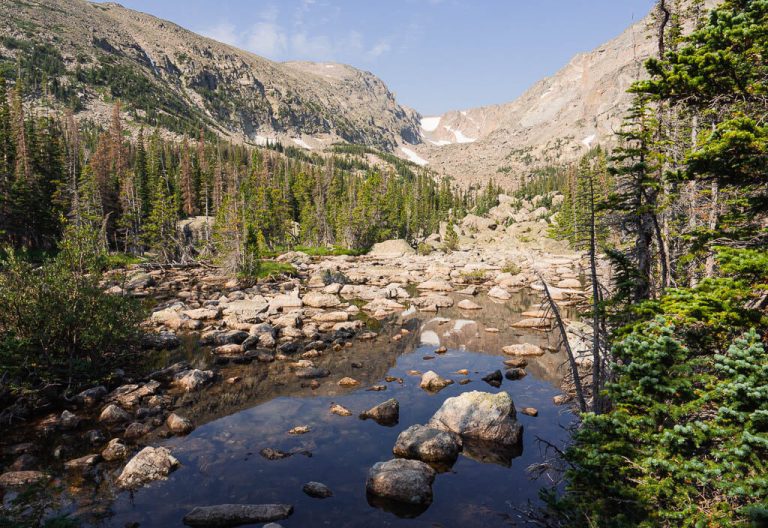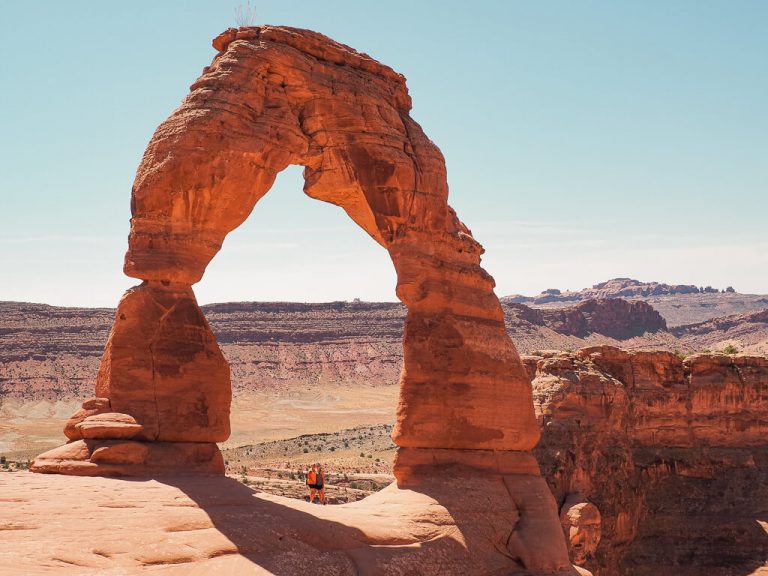Plan a Trip from Zion to Bryce Canyon: 4 Day Utah National Park Itinerary
You have probably found your way here because you are planning a trip from Zion to Bryce Canyon. If that is the case, you are in the right place!
Zion is one of the top 10 national parks in the United States. Its captivating landscape is an outdoor enthusiast’s dream: From hiking the heart-pounding Angels Landing to wading through the Virgin River in the Zion Narrows, and climbing up the 2,000-foot canyon walls.
Bryce Canyon is another very popular national park in Utah. The park is best known for its hoodoos and is actually home to the largest collection of hoodoos in the world.
Let’s dive deeper into our 4-day Bryce Canyon to Zion National Park itinerary, find the best things to do in both of the parks, and get all the information you need about each national park to plan your perfect trip.
Our Other Resources for Zion National Park:
- Best Hikes in Zion National Park
- How to Hike Angels Landing
- Guide to Hiking the Narrows
- Zion National Park Itinerary
This post may contain affiliate links. If you make a purchase through them, we get a small commission at no extra cost to you. It helps us create free content for you to enjoy. Learn more about our disclaimer here. Thanks for your support!
How to get to Zion and Bryce Canyon National Parks
To visit Bryce Canyon and Zion National Park you can technically start from either Las Vegas, Nevada, or Salt Lake City, Utah. No matter where you fly into, it is best to start at Zion National Park and then head to Bryce Canyon National Park.
Zion National Park is located about 3 hours from Las Vegas and about 4 hours and 20 minutes from Salt Lake City.
Helpful Travel Planning Tools For Your National Park Road Trip
Rental Car: Explore breathtaking landscapes on the endless road with your rental car to get a taste of unlimited freedom! l Rentalcars
Travel Insurance: Feel safe on all your adventures around the world with simple and flexible travel insurance for all occasions. l World Nomad
Accommodation: After a day full of adventures, you deserve a good night’s rest. Hotels.com offers cozy accommodations which will make you feel at home. l Hotels.com
National Park Pass: When visiting a couple of National Parks in the US a year, there is no better way to save money than with this National Park Pass. l America the Beautiful Pass
How Far is Bryce Canyon from Zion?
Bryce Canyon and Zion National Parks are close neighbors, that’s why many people decide to visit both parks in one Zion to Bryce Canyon road trip.
The fastest way to reach Bryce Canyon is from the east entrance of Zion National Park on US-89. The drive is approximately 74 miles long and will take you roughly 1 hour and 30 minutes to drive.
From the south entrance of Zion National Park or Springdale, your drive will take a little longer, since you have to pass the windy Zion-Mount Carmel Highway (State Route 9). This part of your journey from Bryce Canyon to Zion National Park is incredibly scenic and you should definitely add it to your Zion National Park bucket list.
You will drive through sandstone tunnels, admire the cross-cut design of the Checkerboard Mesa, and maybe you will be lucky to spot some Desert Bighorn Sheep. They like to hang around in the mountains between the Zion-Mount Carmel Tunnel and the East Entrance. Plan at least 1h 45 min for the 84-mile drive.
Zion National Park
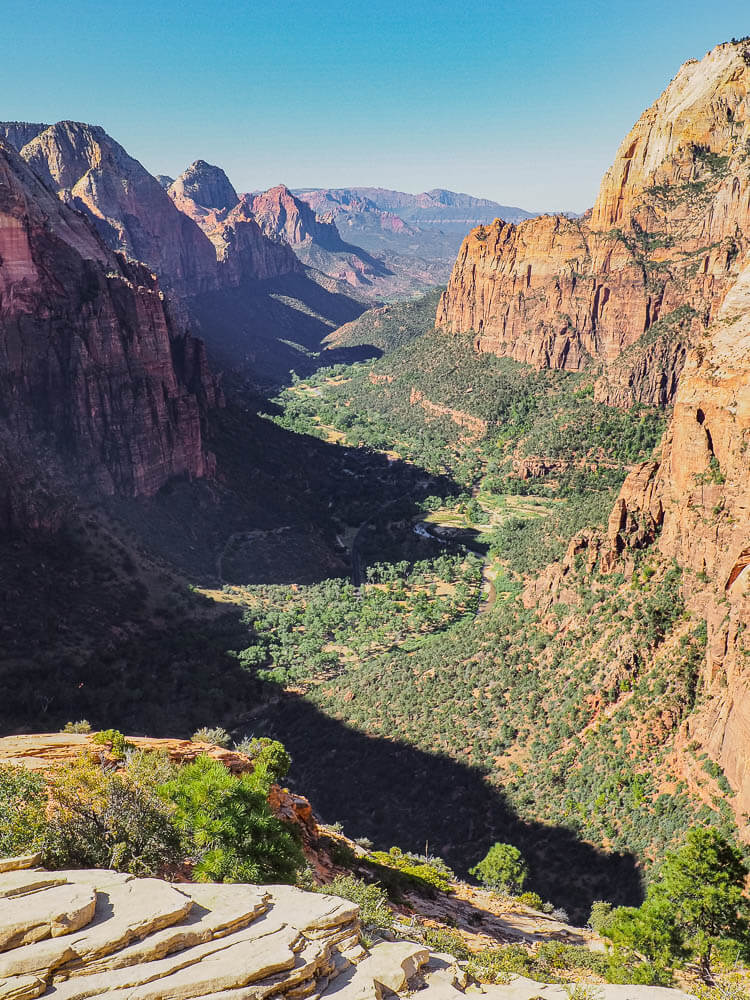
Zion instantly captivates its visitors with its remarkable colorful high canyon walls and thrilling adventures. In this park, you can find some of the most unique hiking trails in the country.
It is Utah’s first National Park of the Mighty 5 and one of the most visited parks in the United States.
Wade through the Virgin River to hike the famous slot canyon, The Narrows, and challenge yourself by climbing up narrow ridges at dizzying heights to the summit of Angels Landing.
Even when you don’t want your adrenaline to rush, you will find plenty of opportunities to fully enjoy the park’s outstanding landscape. Don’t miss out on driving the Zion-Mount Carmel Highway and exploring the Kolob area of Zion.
- Best time to visit: Spring and Fall (April to May and September to October). Avoid crowds by visiting shortly before or after the peak season (April-October).
- Where to stay: If you are looking to stay within park boundaries, South or Watchman Campground are great accommodations as well as the Zion Lodge. If you are looking outside the park, Springdale has some nice but pricey hotels.
- How to get there: The closest airports to Zion National Park are Las Vegas Airport (3-hour drive) and Salt Lake City International Airport (4.5-hour drive).
- How to get around: The park requires visitors to use the free shuttle service to access Zion Canyon most of the time during the year. But you will still need a car to get to Zion.
- Permits: Angels Landing, The Narrows (top-down), The Subway, Rock Climbing, Backpacking
Zion National Park Tips
1. Finding a parking spot
Finding parking can be a nerve-racking task in Zion National Park because spots are limited and fill up quickly. To get a parking spot, you will need to arrive early.
The parking lot was almost completely filled by 7:00 AM when we visited this park in August. You can expect crowds in Zion almost any time of the year, especially from early February to late November.
Top Tip: Didn’t find parking in Zion National Park? Park your car in Springdale and use the FREE Springdale shuttle service to get to the park. The shuttle can pick you up at 9 stops outside the park in town and will drop you off at the pedestrian/bike entrance to Zion.
2. Get permits and make reservations in advance
The U.S. National Parks are extremely popular and attract thousands of visitors every day. To protect the fragile landscapes of the parks, the NPS expanded its ticketing system for Zion National Park.
These popular trails in Zion require a permit:
- Angels Landing
- The Subway
- The Narrows (Through hike from Chamberlain’s Ranch)
To get tickets for Angels Landing and the Subway, you need to apply for the lottery months in advance.
To experience the Narrows through a hike from Chamberlain’s Ranch, you can make a reservation during a two months time frame on recreation.gov.
Reservations for the next month become available every 5th of the current month.
3. Know the weather
One of the most important things you have to consider for Zion is the water flow of the Virgin River if you plan to hike the Narrows. Flash floods and strong currents can be very dangerous. Thunderstorms are common in Utah during the summertime. Do yourself a favor and check the weather conditions before going to Zion.
4. Be up to date on trail conditions
Trail conditions can easily change in Zion National Park, due to major rock falls. Check the park’s website and stop in at the visitor center for the most up-to-date information.
5. Hike in the morning
Beat the crowds on the trails, especially the popular Angels Landing and Narrows, by being on the first shuttle of the day.
How to Get Around Zion
Zion National Park has a free shuttle service that accesses the main Zion Canyon section of the park from the Visitor Center to the Temple of Sinawava.
The shuttle runs most of the year from March through November, and during busy times like the last week in December and weekends in February. Personal vehicles are not allowed on the Zion Canyon Scenic Drive when the shuttles are in service.
The times of operation of the Zion Canyon Shuttle Service get adjusted every year, so make sure to check the park’s website for the most up-to-date information. Usually, the shuttle runs about every 10 to 15 minutes, stopping at all the major trailheads and attractions on the way.
In addition, you can utilize the free Springdale shuttle to get from the cute charming town to Zion National Park and back.
Where to Stay near Zion National Park
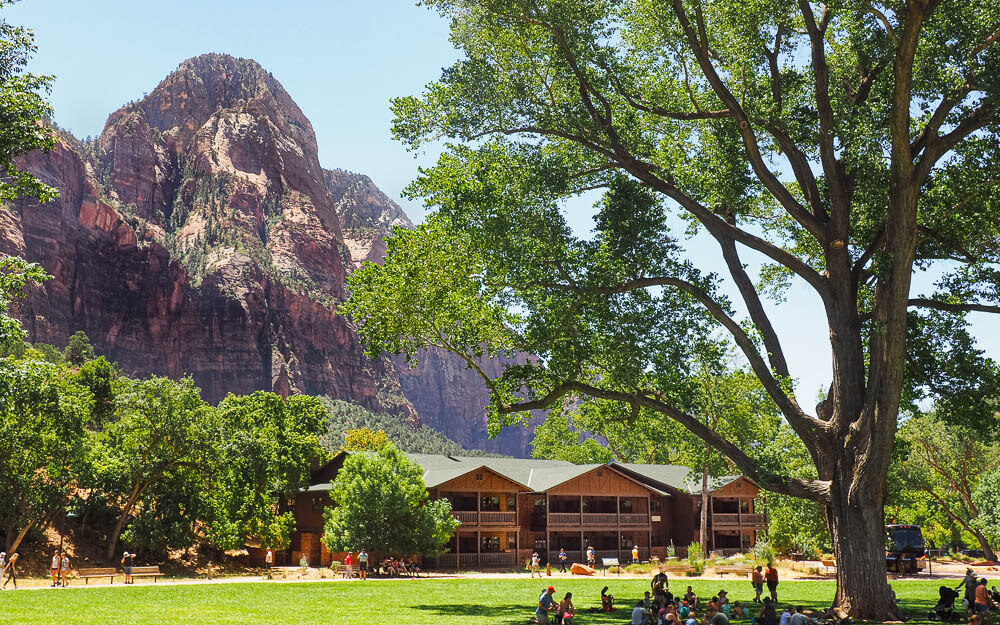
Zion has a variety of accommodations that satisfies all types of travelers from sleeping for free under the stars to staying in a stylish lodge.
If you plan to stay outside of the park in Springdale, plan to book anywhere from 4 to 6 months in advance.
Staying inside the park will require a 6-month in advance booking for campgrounds and 13 months in advance for the Zion Lodge. The lodge starts accepting reservations on the first of every month for the entire month for the same month the following year.
Inside Zion National Park
Camping – There are 3 campgrounds in Zion that require advance reservations. Camping is very popular in the park and campsites tend to book out quickly. Camping is only allowed in these 3 designated camping areas:
- South Campground (reservable 14 days in advance)
- Watchman Campground (reservable 6 months in advance)
- The Lava Point Campground (first come, first serve, typically open May through September)
Lodging – If camping is not your thing, you can stay in Zion Lodge. It is the only lodging inside Zion National Park.
Outside Zion National Park
Dispersed Camping – 30 minutes outside of the park on BLM lands located on Dalton Wash Road for free.
Hotels- Hotels in Springdale are very pricey, so expect to spend a few bucks when you want to spend the nights in the charming small town. These are some of the best options:
Bryce Canyon National Park
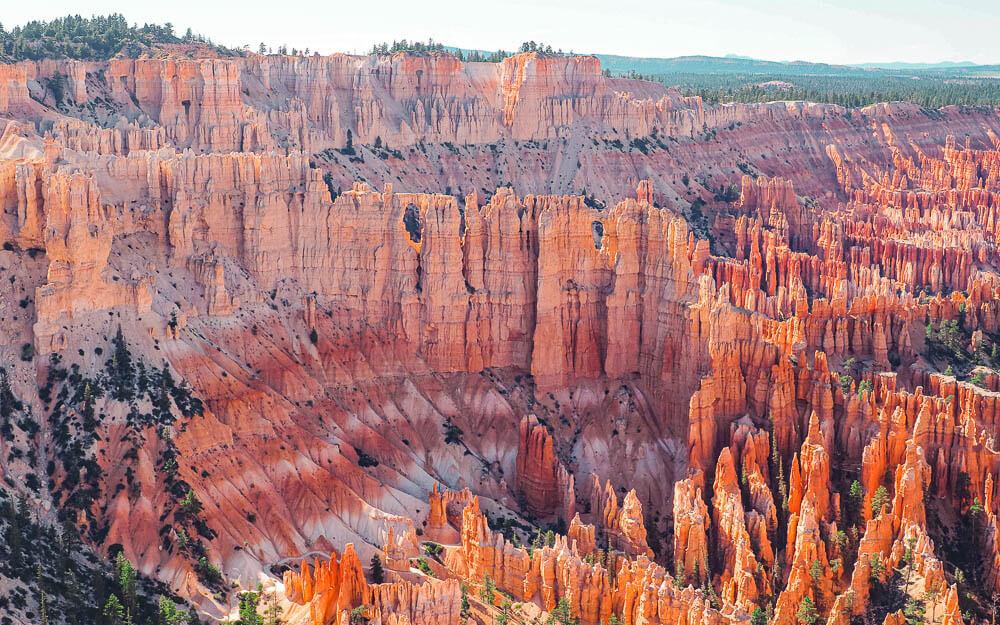
Bryce Canyon is one of the smaller National Parks in the United States. It is located in the American Southwest with an amazingly unique landscape.
The canyon is home to the largest collection of hoodoos in the world. The highest concentration of hoodoos can be found at the Bryce Canyon Amphitheater close to the park’s entrance.
Some of the best ways to explore the park are to hike the gorgeous trails, enjoy the scenic drive and stop at the various viewpoints along the way. You can also join in on a sightseeing tour to learn more about the park or go horseback riding.
- Best time to visit: Spring and Fall (April to May and September to October).
- Where to stay: If you are looking to stay within park boundaries, North or Sunset Campground, and The Lodge at Bryce Canyon are your options. If you don’t mind staying outside the park, you can find good and inexpensive accommodations in close proximity.
- How to get there: The closest airports to Bryce Canyon NP Utah are Las Vegas Airport (4-hours 10 min drive) and Salt Lake City International Airport (4-hour 5 minutes drive). We would recommend visiting Zion National Park first though. From there it is just a short 1.5-hour trip to Bryce Canyon.
- How to get around: It is up to you if you want to take the free Bryce Canyon shuttle which brings you to all the viewpoints and trailheads or if you prefer to drive your own vehicle in the park.
- Permits: None
Bryce Canyon National Park Tips
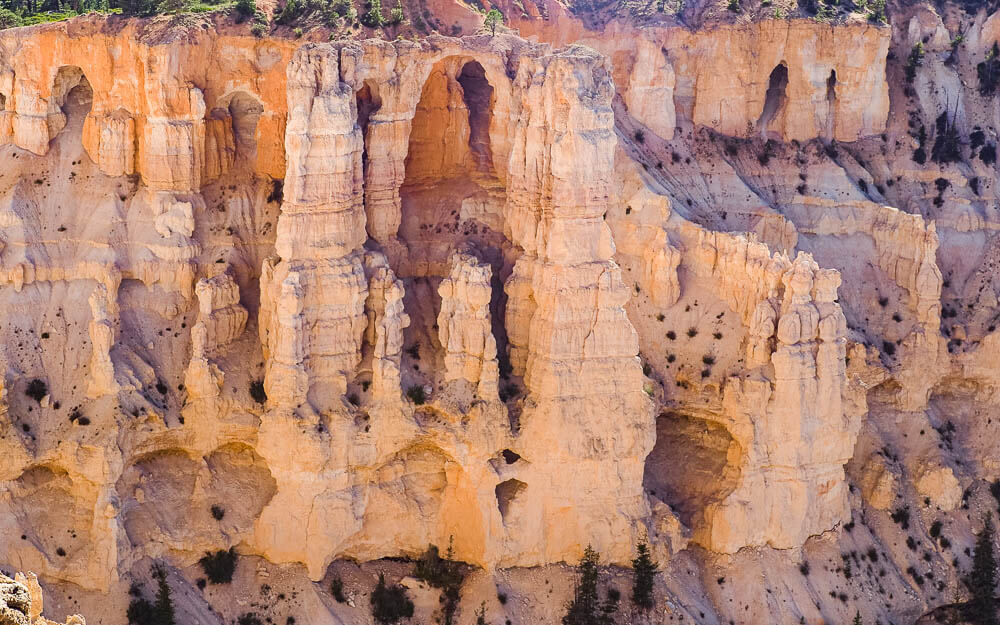
1. Be aware of the altitude
Bryce Canyon National Park sits at a higher elevation, with more than 8,000 feet at its highest point. Especially when hiking up from the Amphitheater, you could experience shortness of breath. Take it slow and remember that a break is always a good opportunity for admiring the awesome landscape.
2. Hoodoo Photography
Bryce Canyon NP Utah has several prime photo spots to capture the remarkable crimson orange-colored hoodoos. Sunrise Point, Sunset Point, Bryce Point, and Inspiration Point should definitely be on your list.
If you want to snag eye-catching photos in a different light, you should visit those places during the sunrise or the golden hour. The golden hour is the time shortly after sunrise and right before sunset.
3. Dress in layers
The temperature difference between the morning hours and the evening hours can vary. Make sure to dress in layers to accommodate the temperature changes.
4. Keep an eye out for wildlife
As we were driving along the Bryce Canyon Scenic Drive we spotted Prairie Dogs popping in and out of their holes and deer relaxing in the pine forests along the road. If you are very lucky, you could also encounter mountain lions, pronghorn deer, and rattlesnakes
How to Get Around Bryce Canyon
You can choose to drive your own vehicle through the park or utilize the Bryce Canyon Shuttle Service. It is a free shuttle service that runs from mid-April through late October.
The shuttle is extremely convenient and easy to use and will bring you to the trailheads, viewpoints, and areas of interest. The buses come every 15 minutes, and you can use the Bryce Canyon Shuttle Tracker to follow the shuttle bus. The entire shuttle run is around 50 minutes in length and you are welcome to get on and off the bus at any of the stops.
Using the shuttle service is optional, but it is highly recommended. First of all, when riding the shuttles, you will do your part to protect the environment by reducing exhaust gasses. Plus, you won’t have to worry about not finding parking for the viewpoints and trailheads in Bryce Canyon.
Find more information about the shuttle stops by visiting the National Park Service website.
Where to Stay near Bryce Canyon National Park
Staying inside the park’s boundaries is a difficult task and requires some advanced planning. Book accommodations at least a minimum of 3 to 6 months in advance.
To stay at the popular Lodge at Bryce Canyon, you will need to book at least a year prior to your trip.
Inside Bryce Canyon NP Utah
Camping – Bryce Canyon has 2 campgrounds within the park. Both campgrounds are a great choice for camping since they are relatively close to the main highlights of the park. Learn more about each campground and how reservations work by visiting the National Park Service website.
- North Campground (first-come, first-served campground, open all year)
- Sunset Campground (reservable 6 months in advance)
Lodging – The Lodge at Bryce Canyon (the only hotel in the park)
Outside Bryce Canyon National Park
Although the towns outside of Bryce Canyon are not as big as Springdale next to Zion National Park, they do provide options for accommodations outside of the park.
Dispersed Camping – Forest Road 1173 (BLM lands) for free just outside the park.
Camping – Ruby’s Inn RV Park and Camping
Hotels – There are some beautiful hotels in close proximity to Bryce Canyon National Park you could stay the nights in:
Zion to Bryce Canyon: 4 Day Itinerary
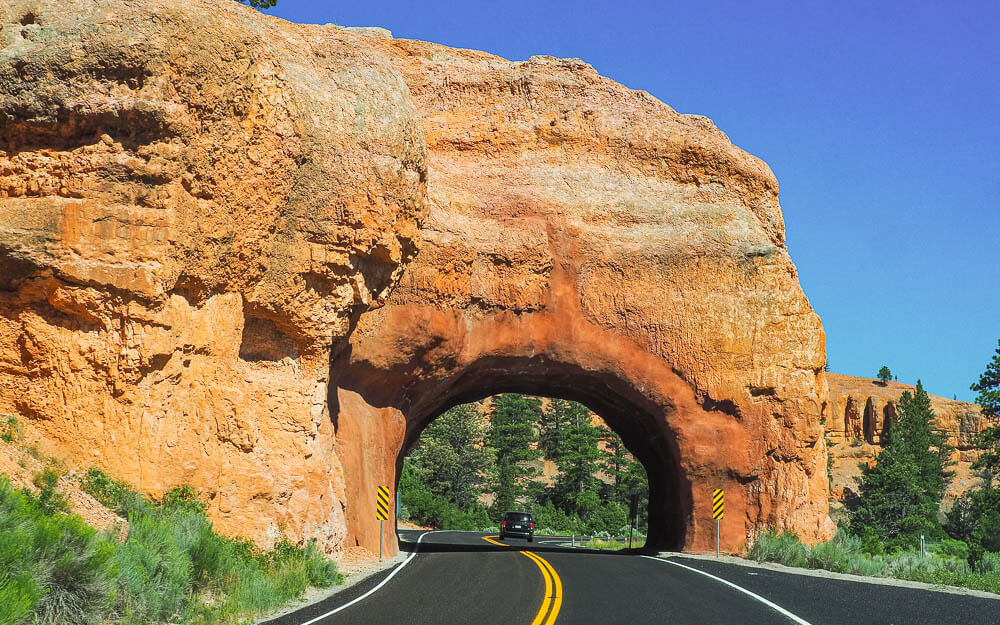
The number of days you choose for your trip is highly dependent on what you want to see and do in the parks. There are so many stunning hiking trails that you could be occupied for weeks.
You can complete your trip in somewhere between 3 and 7 days, but our suggestion is to spend at least 2 days in each park for your Zion to Bryce Canyon trip.
We highly suggest having 4 complete days for this Zion to Bryce Canyon itinerary, which means we recommend flying in the day before and flying out late on the last day or the day after. That gives you enough time to experience the highlights of each park without all the hustle and bustle.
Here is a quick breakdown of what a 4 day Zion National Park to Bryce Canyon National Park itinerary looks like:
Day 1: Zion National Park – Angels Landing + another short hike (Lower Emerald Pools, Pa’rus Trail, or The Watchman Trail), Go stargazing
Day 2: Zion National Park – The Narrows, Zion-Mount Carmel Highway to Bryce Canyon, Canyon Overlook trail
Day 3: Bryce Canyon National Park – Catch a sunrise, Queens Garden & Navajo Loop trail, Bryce Canyon Scenic Drive, watch the sunset
Day 4: Bryce Canyon National Park – Fairyland Loop trail, Mossy Cave trail
Day 1: Zion National Park
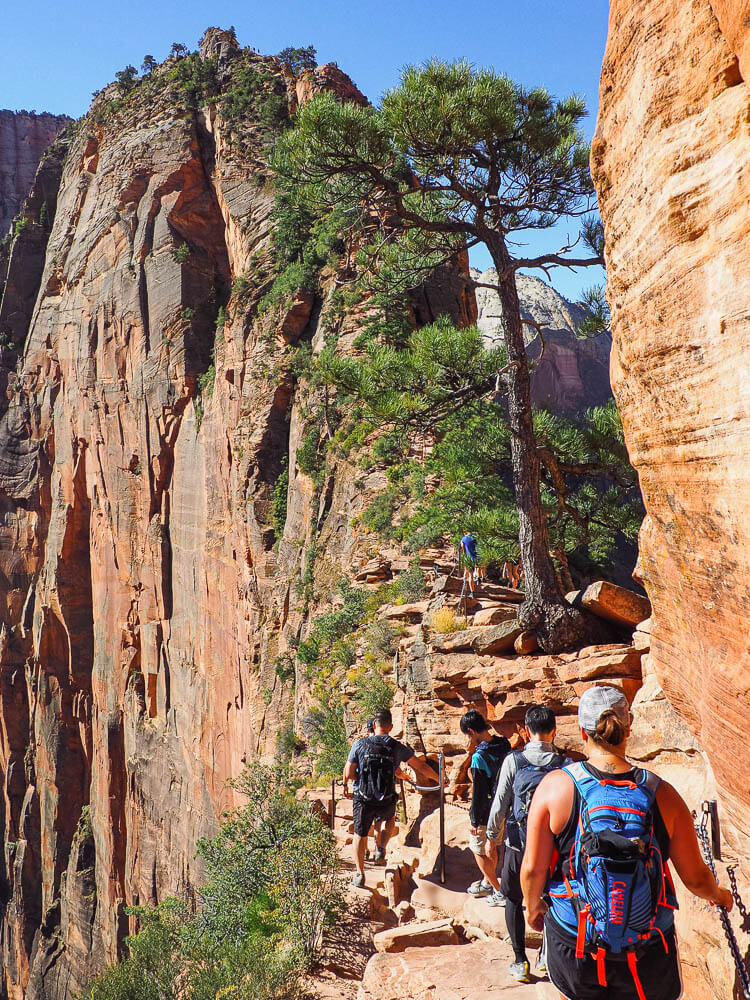
Arrive early in the park and be on the first free shuttle to Zion Canyon. Plan some time to find parking and get in line for the Zion Canyon Shuttle.
6 – 10 AM: Hike Angels Landing
To start your hike to Angels Landing, get off shuttle stop #6, The Grotto. It should take you about 3 or maybe 4 hours to complete the trail, depending on how long you want to take in the breathtaking scenery.
Note: Check the Zion Canyon Shuttle operating times before you go. Every year, the National Park Service adjusts the times a little. Usually, the first shuttle in the summertime leaves the Visitor Center at 6 AM, in the spring and fall the first shuttle might not run until 7 AM.
The Angels Landing hike is not for everyone, it does require a steep and narrow climb to reach the summit. After tackling the switchbacks, you have to walk across a narrow ledge over 1,000 feet using bolted chains to keep your balance.
After about 2.7 miles and approximately 1,500 feet of elevation gain you will reach Angels Landing summit surrounded by sweeping views of Zion Canyon.
Travel Tip: Angels Landing Permit
In Spring 2022 a permit system was introduced to regulate the traffic on the popular Angels Landing trail. A permit is required to tackle any portion of Angels Landing every day of the year.
You have to enter a permit lottery on recreation.gov to get the chance to explore this thrilling trail. Simply choose your preferred dates and times slots. You can either start your hike before 9 AM, between 9-12 AM or after 12 PM.
Especially in the summertime, we would highly recommend starting the trail before 9 AM, since it gets incredibly hot and most of the trail is exposed to the sun.
11 AM: Picnic in front of the Zion Lodge
After climbing down Angels Landing, hop on the shuttle heading back towards the Visitor Center and get off the first stop #5 for Zion Lodge.
Enjoy a picnic lunch with a view on the lawn in front of the beautiful Zion Lodge. Reenergize and give your legs a rest before tackling another shorter, easier hike for the afternoon.
1 PM: Take another short hike
If you are not too exhausted, we would recommend taking a shorter, easier hike in the afternoon.
We personally did the Lower Emerald Pool trail which is located across the street from Zion Lodge. The trail is an easy 1.2 mile out and back which follows a paved lush trail to waterfalls. This hike will feel like a breeze after completing Angels Landing.
The trail was alright in the summertime, but the waterfall was not very impressive, since you won’t see a lot of water dropping down the cliff during that season of the year.
Alternative hiking options are Pa’rus trail or Watchman trail. However, do be mindful the Watchman trail is completely exposed to the sun which may not be a good choice for an afternoon hike on a hot sunny summer day.
3 PM: Explore Springdale
Head just outside of the park into Springdale, Utah, and check out the little town. There are tons of places to grab a bite to eat or have a drink. After a long day of hiking, we couldn’t wait to get a cold beer at the Zion Brewery, just outside the park.
After Dark: Stargazing
Head back into the park and watch the stars. Some of the best places to stargaze in Zion are at the Zion Human History Museum or along the Pa’rus trail. Both locations are just a short walk away from the Visitor Center.
Day 2: Zion National Park
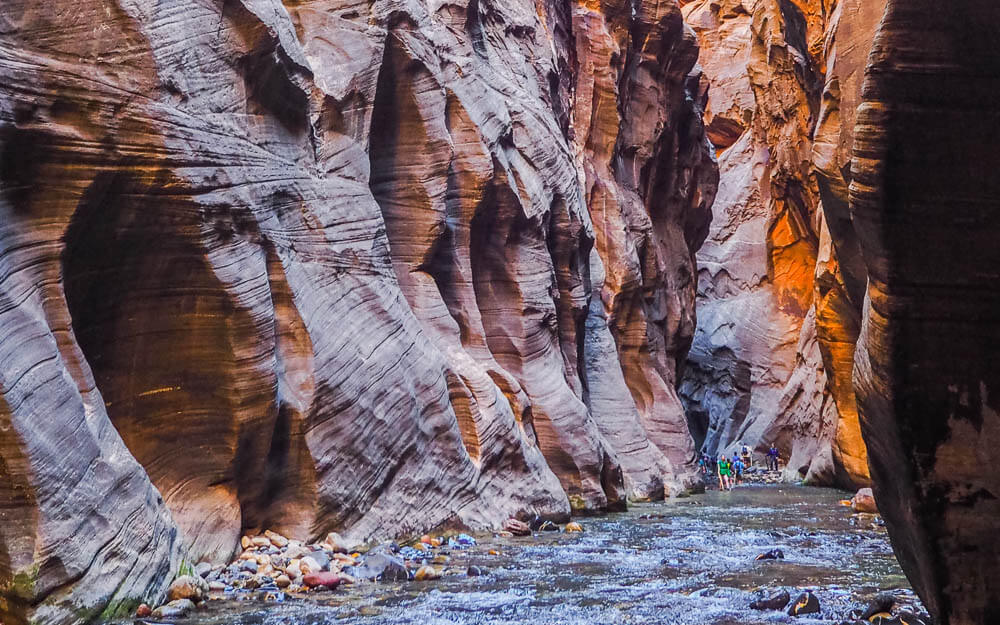
It is day 2 in Zion National Park and we hope your legs are up for it because you have more exciting hiking trails lined up. Wake up early and try to be on the first shuttle going to Zion Canyon again.
6 – 11 AM: Hike the Narrows
This time ride the free shuttle all the way to the end and get off at stop #9, Temple of Sinawava, to start hiking The Narrows. The hike can take anywhere from 1 hour to 8 hours, depending on how far you want to go into the canyon.
The trailhead begins on the Riverside walk from the Temple of Sinawava, which is a paved pathway leading to the river. Once the pathway ends the excitement begins, it is time to wade through the water.
In our opinion, this is a must-do hike in Zion National Park. Instead of hiking, you are actually wading your way through the Virgin River. The water of the Virgin River can be up to your chest and the stream can be quite strong, but the challenge will be totally worth it.
We suggest hiking about 2 miles or so into the canyon before turning around to get the full experience of the Narrows.
Top Tip: To get the full rundown on what to know, what to wear, and a full trail explanation, read our guide to hiking the Narrows. This is a hike you need to be prepared for. Do not try to complete the hike without doing your research first.
11 AM: Check out the Visitor Center
Once you return back from hiking the Narrows, take the shuttle back to the Visitor Center. If you haven’t already, check out the visitor center.
12 – 3 PM: Drive the Zion-Mount Carmel Highway to Bryce Canyon
Enjoy a beautiful scenic 1.5 hours drive on the Zion-Mount Carmel Highway on your way to your next destination: Bryce Canyon NP Utah
At about mile 5 (if you are coming from the south entrance), you will reach the drive’s famous Zion-Mt. Carmel Tunnel. This tunnel is very narrow and usually runs in one direction at a time, so expect delays. The tunnel is about 1 mile long.
If you are looking to stretch your legs for a quick hike, you can pull over just after the tunnel for the Canyon Overlook trail.
On this moderate 1-mile trail, you get quickly rewarded with a perfect view overlooking Zion Canyon without all the hassle of hiking for a long time.
After you have enjoyed one last view of Zion National Park, jump back into your car to finish the drive on the Zion-Mount Carmel Scenic Highway.
Along the rest of the drive, you will reach another park highlight, Checkerboard Mesa. What makes this mesa special is the noticeable cross-cut design.
Make sure you don’t drive too fast, or you might miss out on spotting bighorn sheep between the Zion-Mount Carmel Tunnel and the East Entrance. We almost missed them because they were perfectly camouflaged, resting under a tree.
Additional Options for Zion National Park:
- The Subway – If you are interested in adding the Subway hike to your itinerary, make sure to secure a permit in advance. The Subway is a slot canyon hike similar to the Narrows with more technical and challenging aspects, such as extensive route finding and rappelling.
- Hidden Canyon Trail – Less crowded than Angels Landing, the Hidden Canyon Trail offers similar heart-pumping thrills with dramatic drop-offs and the use of chains along the hike.
- West Rim Trail – Explore Zion’s backcountry on the best backpacking trail in the park.
- Zion Human History Museum – Take a break from the trails and visit the Zion Human History Museum to learn about Zion’s past. Unfortunately, the museum is temporarily closed (as of April 2022), so make sure to check the park’s website for the latest information.
Day 3: Bryce Canyon National Park
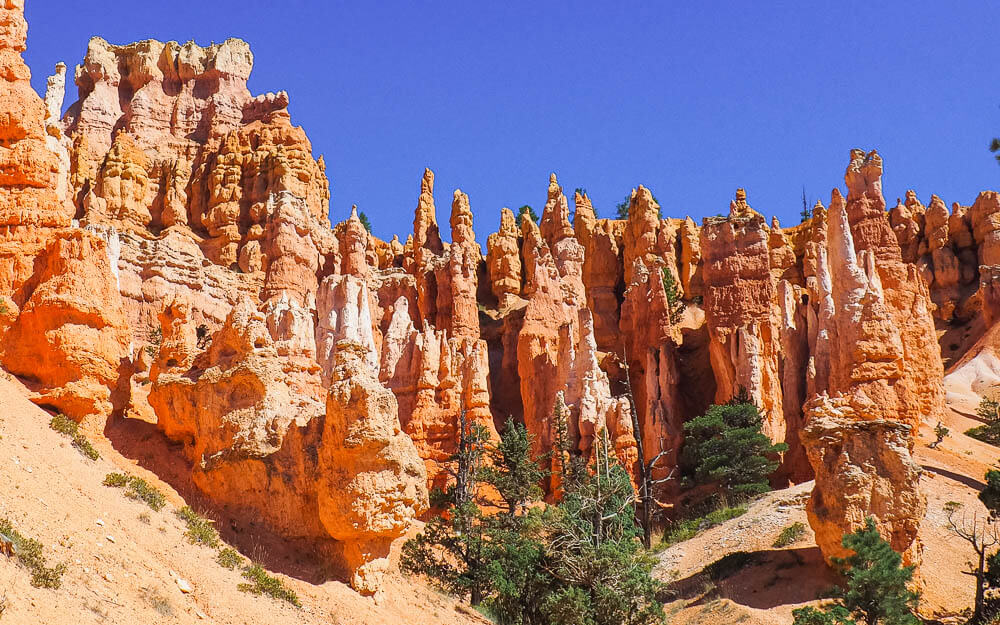
After a good night’s rest, it is once again time to rise before the sun.
Sunrise – View the sunrise from Sunrise Point
Get in your car and drive to Sunrise Point along the Bryce Canyon Scenic Drive early to catch the famous Bryce Canyon hoodoos glow in the first sunlight of the day. Make sure to arrive at least 30 minutes before sunrise to snag a parking spot.
After the sun has risen it is time to hike with the hoodoos. Walk along the Rim Trail from Sunrise Point to Sunset Point.
8 – 11 AM: Hike the Queen’s Garden & Navajo Loop Trail
This is the most popular trail in Bryce Canyon. The hike can be completed by starting at either Sunrise Point or Sunset Point.
Our preferred route is to begin at Sunset Point, where you will descend Wall Street, a switchback section leading you through towering sandstone formations. You will continue your way through the Amphitheater getting up close to the famous Bryce Canyon hoodoos until you reach the rim at Sunrise Point.
Note: The Wall Street section of Bryce Canyon is closed during the winter months, but you can still take the Queens Garden Navajo Loop trail via Two Bridges.
On this trail, you will walk through natural sandstone arches, and lush pine forests, and pass popular hoodoos like Queen Victoria, and Thor’s Hammer.
12 – 3 PM: Bryce Canyon Scenic Drive
Spend the afternoon checking out the Bryce Canyon Scenic Drive and stop at the various viewpoints along the way. The drive is a 38 miles round trip. You should plan for about 3 hours to complete the entire route.
Experiencing the Bryce Canyon Scenic Drive is one of the best things to do in the park. It is also the easiest and quickest way to encounter the famous hoodoos of Bryce Canyon. The drive runs the entire length of the park which allows visitors to see all angles of Bryce Canyon’s one-of-a-kind landscape.
To tackle the scenic drive, get to the end first and stop at the 13 viewpoints on the way back. It is easier this way because then all the viewpoints will be on your right-hand side. You can pull in and out without difficulties, instead of crossing the road.
Here is a list of the 13 viewpoints on the Bryce Canyon Scenic Drive. We have ordered it starting at #13 to #1 since it is best to begin at the end.
13. Rainbow Point & Yovimpa Point
12. Black Birch Canyon
11. Ponderosa Canyon
10. Agua Canyon
9. Natural Bridge
8. Piracy Point & Farview Point
7. Swamp Canyon
6. Paria View
5. Bryce Point
4. Inspiration Point
3. Sunset Point
2. Sunrise Point
1. Fairyland Point
Find out more about the Bryce Canyon Scenic Drive and the 13 viewpoints.
Sunset – View the sunset from Sunset Point
Head back to Sunset Point to watch the sunset over the hoodoos. It is a perfect way to end your day in Bryce Canyon. Go there early since it tends to get packed quickly.
Day 4: Bryce Canyon National Park
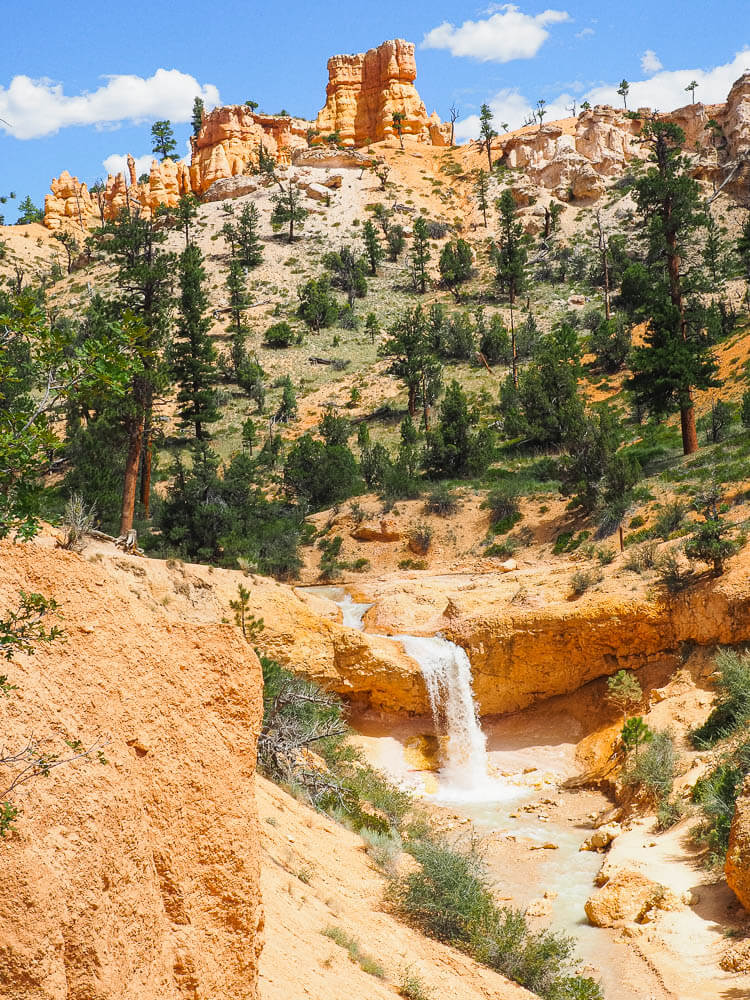
If you haven’t figured out the trend yet, don’t waste time, get up early. It is your last day on your Bryce Canyon to Zion National Park road trip.
8 AM – 1 PM: Hike the Fairyland Loop
Start your day early and head to Fairyland Point, which is the first viewpoint you will come across as you enter Bryce Canyon National Park.
Head into Fairyland Canyon on the Fairyland Loop trail where you will walk through dramatic hoodoo formations. The hike will take anywhere from 4 to 5 hours to complete.
Expect this hike to be strenuous because of the length and the elevation changes. Don’t let that stop you from seeing the northern, more secluded portion of the park.
Plus, it will give you access to the Tower Bridge and Chinese Wall, two spectacular hoodoo formations you are just able to see on this trail.
2 – 4 PM: Hike the Mossy Cave Trail
Jump back into your car, it is time to see another section of Bryce Canyon National Park. Head to the north end of the park, 4 miles east on Highway 12, and hike the easy Mossy Cave trail.
The Mossy Cave trail is the northernmost hike and has one of the lowest elevation gains in the park. It is just under a mile and takes about 1 hour to complete. Parking is extremely limited.
The hike leads you along a stream to a mossy grotto. On your way, you will also spot a small waterfall in front of the picturesque hoodoo landscape.
In the summertime, you will see water dripping from the moss in the grotto, whereas in the wintertime, the grotto is filled with beautiful icicles.
Additional Options for Bryce Canyon National Park:
- Peekaboo Loop Trail – Explore more of the famous Bryce Canyon hoodoos from the heart of the park. On this trail, you will have the chance to see more secluded hoodoo formations, like the Wall of Windows.
- Horseback Riding – Ride into the canyon on a horseback for another adventurous way to get up close to the park’s best features, the hoodoos.
Visiting more Utah National Parks
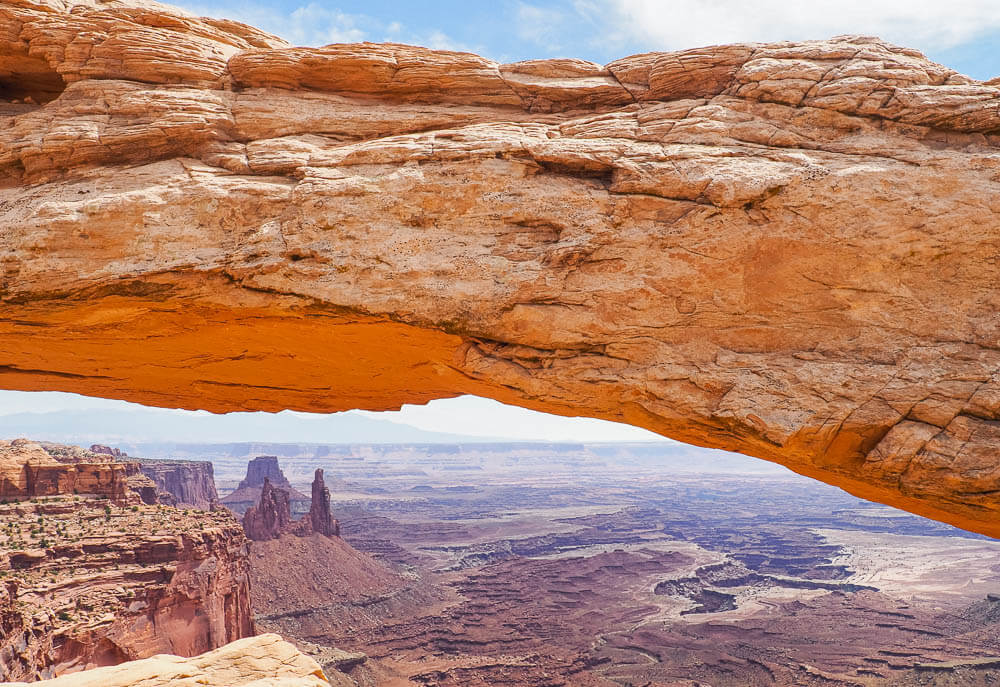
If you are interested, you can easily continue visiting more Utahs National Parks.
In addition to Zion and Bryce Canyon National Parks, there are 3 more national parks with unique landscapes and unforgettable outdoor adventures:
- Arches National Park: See the highest concentration of natural arches.
- Capitol Reef National Park: Navigate yourself through narrow canyon walls.
- Canyonlands National Park: Get a birds-eye view of the vast, deep canyon landscape.
What to Pack for Zion and Bryce Canyon National Parks
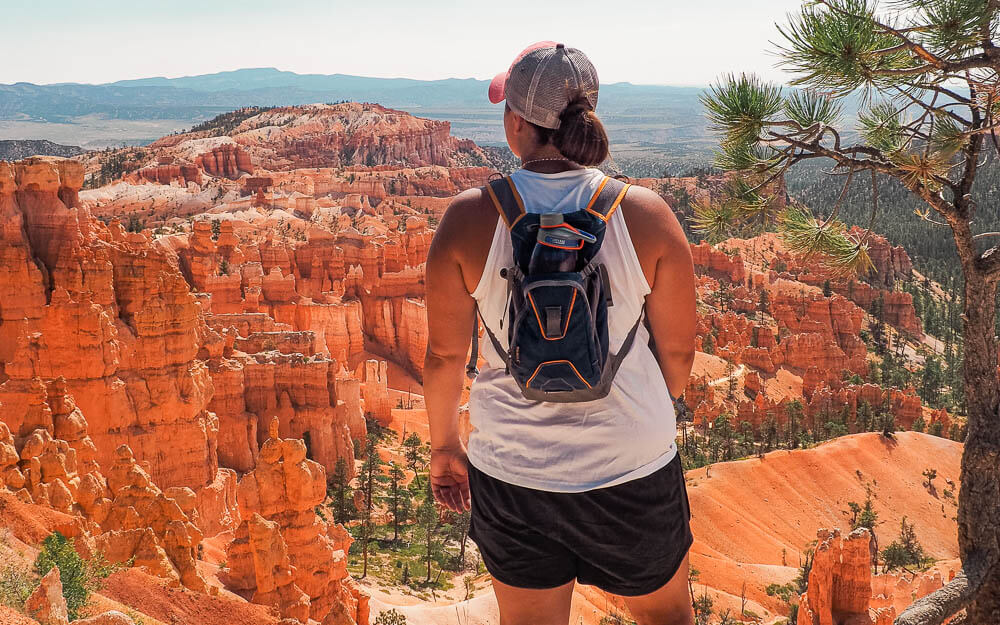
When packing for your trip from Zion National Park to Bryce Canyon National Park, you will require appropriate hiking gear, especially when you plan on hiking the Narrows.
Daypack – A daypack is essential for your hikes. Try out the comfortable lightweight Deuter Speed Lite daypack. It is our choice when hitting the trails.
Dry Pack – When you decide to hike the Narrows in Zion you will be walking through deep water. It is best to use a dry pack to avoid getting your precious gear wet.
Water Bottle – Keep your water cool by bringing an insulated water bottle. We always carry our Hydro Flask water bottles with us.
Comfortable Hiking Boots – One of the worst things when heading out for a hike is not having comfortable footwear. For hiking in Bryce and Zion National Parks, it is best to use over-the-ankle hiking boots because they provide you with good support on the more rocky and difficult terrain.
Quick Drying Clothing – You will want to wear clothes that dry quickly since you will be in and out of water frequently on the Narrows hike. These clothes are also best for the hot temperatures in Utah during the summer months.
Hiking Stick or Trekking Pole – Trekking poles or hiking sticks are a must when hiking the Narrows. They make a huge difference when trying to walk through the water because they help stabilize you on the uneven slippery ground. We found ourselves using them more than we thought we would.
Sun Protection – Most of the trails in Bryce Canyon and Zion NP are in the direct sun. Don’t forget to use sunscreen, a hat, and sunglasses to protect yourself from the grueling sun beating down on you.
Camera & Accessories – Don’t forget to pack a camera to capture all the memories you are about to make during your trip from Zion to Bryce Canyon National Park. Our essential camera gear is our Olympus OMD Em Mark ii, the Rollei travel tripod, a camera remote, and our Peak Design capture clip.
Top Tip for Hiking the Narrows
When we hiked the Narrows, we saw people wearing a variety of different shoes. Many people try to hike the Narrows in hiking sandals, which is definitely NOT recommended! The rocks can be very sharp, which puts you at a high risk of getting injured. Choose over-the-ankle hiking boots instead.
We found it best to just wear our regular hiking boots. Yes, they were soaked after our trip but they dried in about a day.
If you are not satisfied with the gear you already have to hike the Narrows, there is an option to rent gear just outside the park at Zion Outfitters. Find out more about rental options on their website.
Best Time to Visit Utah’s National Parks
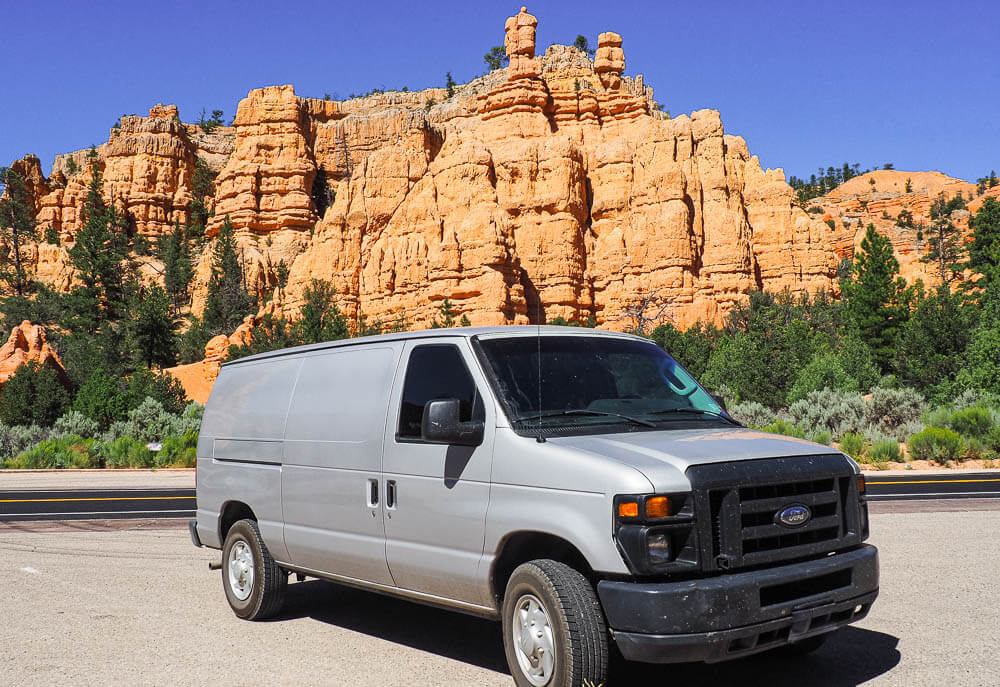
The overall best time to visit all of Utahs National Parks is during the spring (April-May), and fall (September-October).
During these months, daytime temperatures range from 60-80 degrees, making outdoor activities perfectly enjoyable.
Each season does provide a different and unique experience in the parks. So if you can’t make it during the ideal time, don’t worry too much.
You can make it work. We visited all of Utahs National Parks in the summer (August) on our 9-week road trip through the United States. Yes, temperatures were hot but if you plan your day out accordingly and start early in the morning, you will be fine.
Best General Tips for Visiting Zion and Bryce Canyon National Parks
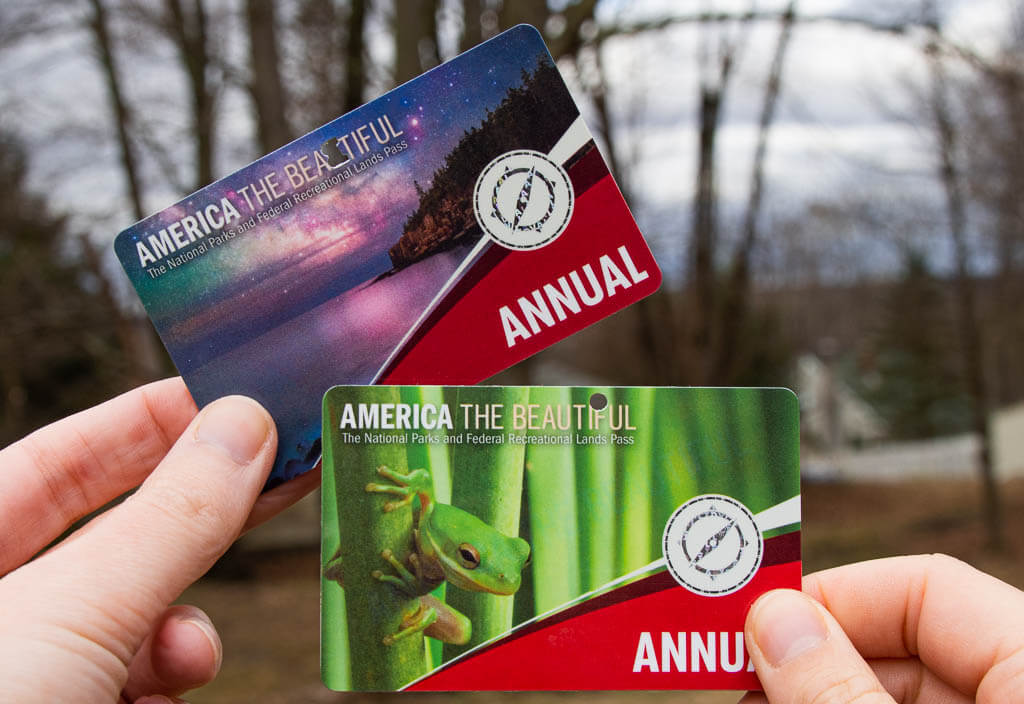
There are some things you should know when planning a trip from Zion to Bryce Canyon NP Utah:
1. Buy an America the Beautiful Pass
Purchase an America the Beautiful Pass for only $80. This is the best way to save money on all the National Parks, and even more National Park Service Sites.
Here are a few reasons why the pass is worth it:
- FREE Access to over 2,000 Public Lands for 1 Whole Year
- Quickly Pays for Itself – can’t beat the price!
- There is an America the Beautiful pass for everyone – 6 available pass options
- Share Your Pass with Friends and Family – the pass is able to have 2 owners
- Supports Funding to America’s Public Lands
2. Get the most out of your days
If you are not a morning person, you have to get over it because visiting Bryce Canyon and Zion NP requires early mornings. Trust us, getting out of bed will be absolutely worth it.
Here are just a few reasons why starting your day early is so important:
- Avoid the crowds
- Hike in moderate temperatures
- Escape the battle of finding a parking spot
- Enjoy the maximum amount of daylight in the park
3. Download the NPS Apps
If you haven’t already, download the National Park Service App, and the Recreation.gov App.
National Park Service App: This functional app provides information on all the National Park Service sites across the U.S. You can easily find sites that are close by, use it to create a list of the National Parks you have visited and the ones you would like to see. This app makes it super easy and convenient to start planning your trip to any US National Park.
Recreation.gov: Most people know this app for booking campsites, especially in the U.S. National Parks, but it has much more to offer. Through the app or website, you can book permits, tours, shuttle tickets, passes, and get additional information on different destinations and activities.
Top Tip: For Zion National Park you can also use this app to apply in the lottery system to hike Angels Landing.
4. Stop at the Visitor Centers
Making a quick stop at the US National Park visitor centers can be extremely useful. Here you can gather more information about the park from a knowledgeable park ranger. You can also purchase gear, check out park exhibits or films, use the restroom, and fill up your water bottle.
5. Follow the Leave No Trace Principles
Please recreate responsibly. Anytime you are exploring and enjoying the outdoors, it is important to remember to follow the Leave No Trace principles. Respect and appreciate nature, so that future generations can enjoy the same beauty. If you aren’t familiar with the Leave No Trace Principles, here they are:
- Plan Ahead & Prepare
- Travel on Durable Surfaces
- Properly Dispose of Waste
- Leave What You Find
- Minimize Campfire Impacts
- Respect Wildlife
- Be Considerate of Others
FAQs about Zion to Bryce Canyon National Park
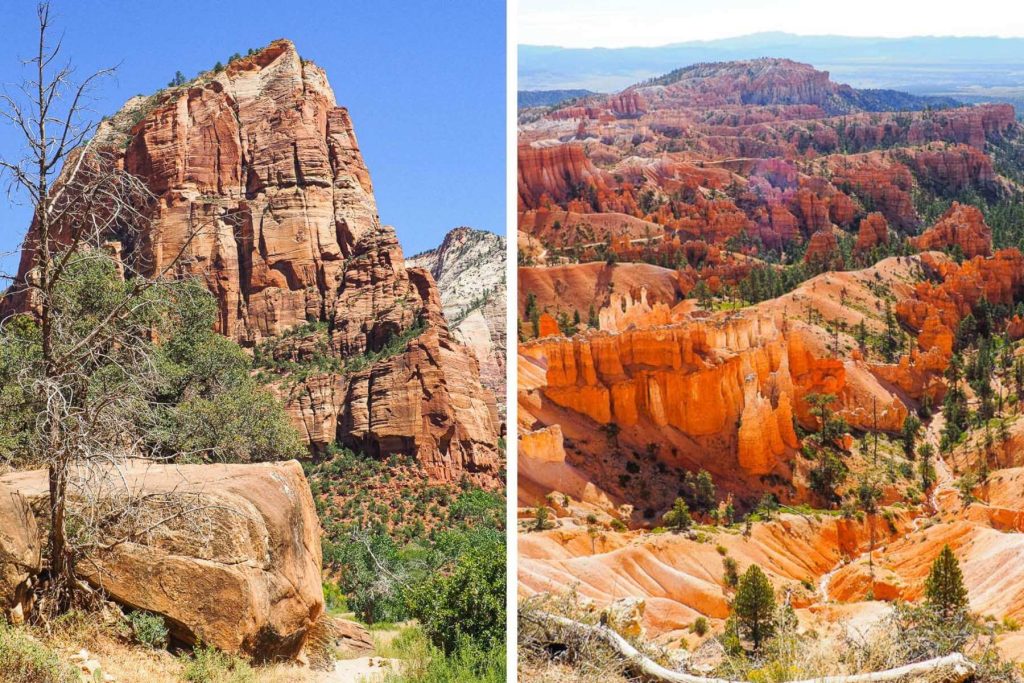
Can you do Zion and Bryce Canyon National Parks in one day?
Technically you could “see” Bryce and Zion National Parks in 1 day, but we would not recommend doing that. At best, you may be able to squeeze in the Zion-Mount Carmel Highway and the Bryce Canyon Scenic Drive.
If you are able to do that, it would be a very long day driving and you would miss out on really enjoying the parks and exploring the stunning hiking trails.
Should I spend more time in Zion or Bryce?
We think visiting each park for at least a minimum of 2 days will allow you to enjoy the main park features. You can easily spend more time in each of those national parks. In which park you might want to spend more time, depends on your interests and how you like to experience a national park.
What are you looking for?
- Unique (and thrilling) hiking experiences → Spend more time in Zion
If you are in search of adventure, then Zion has a lot of options. Here, you have the opportunity to hike on some of the most thrilling and unique hiking trails in the United States. Besides the Narrows and Angels Landing, hiking the Subway is an outstanding experience, as well as taking a backcountry trip. The list of stunning hikes in Zion is countless.
- Stunning geology and incredible viewpoints → Spend more time in Bryce Canyon
If you are looking for stunning viewpoints, one-of-a-kind rock formations, or if you are into photography, you might want to extend your visit to Bryce Canyon NP Utah. In our opinion, the major highlights of the park are easily accessible, which benefits a wide range of visitors.
We spent more time in Zion National Park because we wanted to explore a lot of hiking trails in that park. Zion National Park was one of our favorite parks in the USA to explore. From what we gather, it seems like the majority of visitors do the same.
How many days do you need in Zion?
Zion National Park can be best explored in 1-5 days. Whereas 1 day will just give you a glimpse of all the beauty the park has to offer, 5 days would be perfect to enjoy all the highlights and more hidden places, which are well worth a visit.
How many days do you need in Bryce Canyon?
Bryce Canyon National Park is best explored between 1 to 3 days. With 1 day in Bryce Canyon, you will be able to explore the main park highlights. More than 1 day will allow you to explore the backcountry of Bryce Canyon.
How far is Bryce Canyon from Zion?
Bryce Canyon Zion are close neighbors, that’s why many people decide to visit both parks in 1 trip.
The fastest way to reach Bryce Canyon is from the east entrance of Zion National Park on US-89. The drive is approximately 74 miles long and will take you roughly 1 hour and 30 minutes to drive.
From the south entrance of Zion National Park or Springdale, your drive will take a little longer, since you have to pass the windy Zion-Mount Carmel Highway (State Route 9). Plan at least 2 hours for the 86-mile drive.
Where Should I Stay Between Bryce Canyon and Zion NP?
If you rather stay in a more centrally located area to visit Zion and Bryce Canyon National Parks, find accommodation in any of the small towns along US-89.
The towns of Glendale, Orderville, and Mount Carmel Junction are closer to Zion National Park and Hatch, Utah, is closer to Bryce Canyon National Park.
Is Bryce Canyon as busy as Zion?
Bryce Canyon is not as busy as Zion. Zion season is more than double the number of visitors a year than Bryce Canyon. If you are looking for lesser crowds, then Bryce Canyon NP Utah is the park for you.
How far is Zion from Las Vegas?
Zion National Park is roughly 3 hours from Las Vegas Nevada with about 160 miles in between. Driving from Las Vegas to Zion or Zion to Las Vegas, you will jump time zones. Utah is 1 hour ahead of Arizona.
If you have some time for a detour, we suggest stopping at Valley of the Fire State Park.
What was the favorite part of your Zion to Bryce Canyon trip? What national park did you spend more time in?
Share your experiences with us or drop a question in the comments below!
Our Other Resources for Zion National Park:
- 11 Best Hikes in Zion National Park
- A Guide to Hike the Narrows in Zion National Park
- How to Hike Angels Landing in Zion National Park
- Zion National Park Itinerary: Spend 1-5 Days
Our Other Resources for Bryce Canyon National Park:
More Resources for National Parks:
- ROAD TRIP: 100+ Tested Road Trip Pack List Essentials You Will Not Want to Forget
- ROAD TRIP: 45 Useful Gifts for Road Trips You Didn’t Know You Needed
- ARCHES: 8 Incredible Trails to Hike Arches National Park
- CANYONLANDS: The Best of Island in the Sky Canyonlands National Park
- CAPITOL REEF: Explore 10 Striking Capitol Reef Hikes in the Fruita District
- HIKING: What You Should be Packing for a Hike: The Essentials + Extras
- NATIONAL PARK: A Complete National Park List by State + Downloadable Checklist and Map
- QUOTES: 90+ Road Trip Quotes to Excite You to Hit the Road
Save this Post for later on Pinterest!

Did you like this post? Subscribe to our newsletter and we’ll send you more unique travel tips, updates, and even FREE content!
